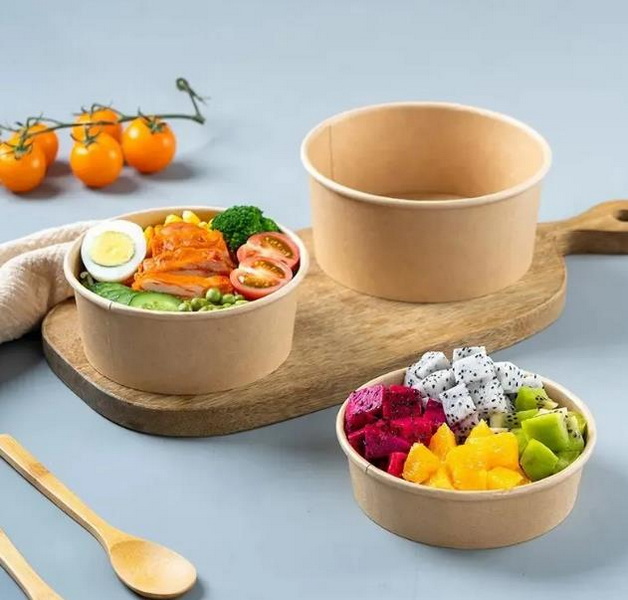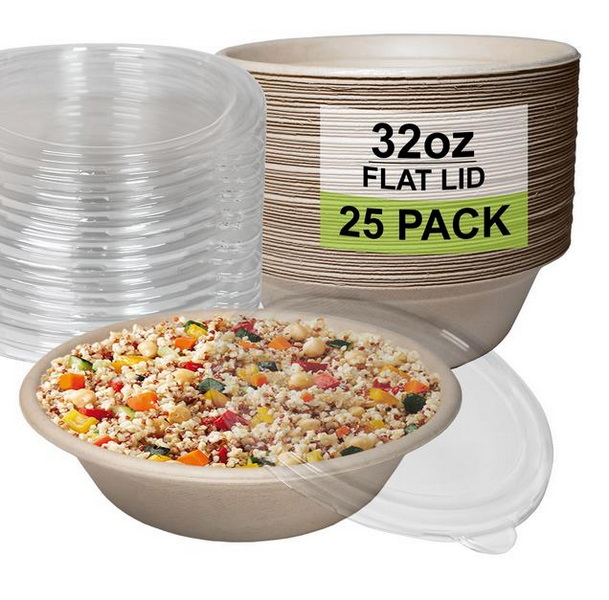
Content Menu
● The Rise of Eco-Friendly Disposable Serving Bowls
● Materials Used in Eco-Friendly Disposable Serving Bowls
● Benefits of Eco-Friendly Disposable Serving Bowls with Lids
>> 1. Environmental Sustainability
>> 2. Versatility and Convenience
>> 3. Health and Safety
>> 4. Aesthetic Appeal
● Challenges and Considerations
● Industry Innovations and Future Prospects
● Case Studies: Successful Implementation of Eco-Friendly Bowls
>> 1. Green Leaf Restaurant Chain
>> 2. EcoEvents Catering Company
>> 3. University Campus Dining
● How to Choose the Right Eco-Friendly Disposable Serving Bowl with Lid
● Implementing Eco-Friendly Bowls in Your Business or Home
● The Impact of Consumer Choices
● Conclusion
● Frequently Asked Questions (FAQ)
>> 1. How long do eco-friendly disposable serving bowls with lids take to decompose?
>> 2. Can eco-friendly disposable serving bowls with lids be used in the microwave?
>> 3. Are eco-friendly disposable serving bowls with lids more expensive than traditional plastic options?
>> 4. How do I properly dispose of eco-friendly disposable serving bowls with lids?
>> 5. Can eco-friendly disposable serving bowls with lids hold hot liquids safely?
● Citations:
In recent years, there has been a growing concern about the environmental impact of single-use plastics and other non-biodegradable materials. This has led to an increased demand for eco-friendly alternatives in various industries, including food packaging and serving ware. One area of particular interest is the availability of eco-friendly disposable serving bowls with lids. These products offer convenience and sustainability, making them an attractive option for both consumers and businesses alike.

The Rise of Eco-Friendly Disposable Serving Bowls
Eco-friendly disposable serving bowls with lids have gained popularity due to their numerous benefits. These bowls are typically made from renewable resources such as sugarcane fiber, bamboo, or palm leaves, which are biodegradable and compostable[1]. This means that they can break down naturally without leaving harmful residues in the environment.
One of the primary advantages of using eco-friendly disposable serving bowls with lids is their reduced environmental impact compared to traditional plastic alternatives. These bowls help minimize plastic waste and contribute to a more sustainable future[2]. Additionally, they often require less energy to produce, further reducing their carbon footprint.
Materials Used in Eco-Friendly Disposable Serving Bowls
Several materials are commonly used in the production of eco-friendly disposable serving bowls with lids:
1. Sugarcane Fiber (Bagasse): This material is derived from the fibrous residue left after extracting juice from sugarcane. It is biodegradable, microwave-safe, and resistant to oil and water[4].
2. Bamboo: Known for its rapid growth and renewability, bamboo is an excellent material for eco-friendly bowls. It is sturdy, naturally antibacterial, and biodegradable.
3. Palm Leaves: Bowls made from fallen palm leaves are 100% natural and biodegradable. They have a unique, rustic appearance and are suitable for both hot and cold foods[7].
4. PLA (Polylactic Acid): This plant-based plastic alternative is derived from renewable resources like corn starch. It is compostable under specific conditions and offers a clear, plastic-like appearance.
Benefits of Eco-Friendly Disposable Serving Bowls with Lids
The use of eco-friendly disposable serving bowls with lids offers numerous advantages:
1. Environmental Sustainability
By choosing these bowls, consumers and businesses contribute to reducing plastic waste and minimizing their environmental impact. The biodegradable nature of these bowls ensures that they break down naturally, returning nutrients to the earth[8].
2. Versatility and Convenience
Eco-friendly disposable serving bowls with lids are suitable for a wide range of foods, including hot soups, salads, and desserts. The lids provide added convenience for transportation and storage, making them ideal for takeout, catering, and outdoor events[5].
3. Health and Safety
Many eco-friendly bowls are free from harmful chemicals like BPA, which are often found in plastic containers. This makes them a safer option for food storage and consumption[6].
4. Aesthetic Appeal
Eco-friendly bowls often have a natural, rustic appearance that can enhance the presentation of food. This aesthetic appeal can be particularly beneficial for businesses looking to improve their brand image and appeal to environmentally conscious consumers.
Challenges and Considerations
While eco-friendly disposable serving bowls with lids offer many benefits, there are some challenges to consider:
1. Cost: Eco-friendly options may be more expensive than traditional plastic bowls, which can be a barrier for some consumers and businesses[8].
2. Availability: Although becoming more common, eco-friendly bowls may not be as readily available as plastic alternatives in all locations.
3. Performance: Some eco-friendly materials may not perform as well as plastic in certain situations, such as with very hot or oily foods.
4. Disposal: While these bowls are biodegradable, they often require specific composting conditions to break down properly. Proper disposal education is crucial for maximizing their environmental benefits.
Industry Innovations and Future Prospects
The market for eco-friendly disposable serving bowls with lids continues to evolve, with ongoing research and development focused on improving performance, reducing costs, and expanding material options. Some notable innovations include:
1. Enhanced Heat Resistance: Researchers are working on improving the heat resistance of plant-based materials to make them suitable for a wider range of hot foods.
2. Improved Water Resistance: New coatings and treatments are being developed to enhance the water resistance of biodegradable bowls without compromising their compostability.
3. Smart Packaging: Integration of QR codes or NFC tags on eco-friendly bowls to provide consumers with information about proper disposal and the environmental impact of their choice.

Case Studies: Successful Implementation of Eco-Friendly Bowls
Several businesses have successfully incorporated eco-friendly disposable serving bowls with lids into their operations:
1. Green Leaf Restaurant Chain
This national restaurant chain switched to compostable sugarcane fiber bowls for all their takeout orders. They reported a 30% reduction in plastic waste within the first year of implementation and received positive feedback from environmentally conscious customers.
2. EcoEvents Catering Company
By using palm leaf bowls with biodegradable lids for their catering services, EcoEvents saw a 25% increase in bookings from clients specifically seeking eco-friendly options. They also reduced their overall waste management costs by 15%.
3. University Campus Dining
A large university replaced all plastic bowls in their dining halls with PLA-based compostable alternatives. This initiative led to a 40% reduction in non-recyclable waste and increased student engagement in sustainability programs.
How to Choose the Right Eco-Friendly Disposable Serving Bowl with Lid
When selecting eco-friendly disposable serving bowls with lids, consider the following factors:
1. Material: Choose a material that aligns with your specific needs and values (e.g., heat resistance, water resistance, or aesthetic preferences).
2. Certifications: Look for bowls certified by recognized organizations such as the Biodegradable Products Institute (BPI) or TÜV Austria to ensure their compostability claims are valid.
3. Size and Shape: Select bowls that are appropriate for your intended use, considering factors like portion sizes and storage requirements.
4. Lid Design: Ensure the lids fit securely and are made from compatible eco-friendly materials.
5. Supplier Reputation: Choose suppliers with a strong commitment to sustainability and transparent production practices.
Implementing Eco-Friendly Bowls in Your Business or Home
To successfully integrate eco-friendly disposable serving bowls with lids into your operations or daily life, consider these steps:
1. Educate: Inform employees or family members about the benefits and proper use of eco-friendly bowls.
2. Gradual Transition: Start by replacing a portion of your traditional bowls with eco-friendly alternatives to assess their performance and reception.
3. Proper Disposal: Establish clear guidelines for disposing of used bowls, including information on composting facilities if available in your area.
4. Feedback Loop: Regularly gather feedback from users to address any concerns and improve the implementation process.
5. Promote Your Efforts: If you're a business, communicate your use of eco-friendly bowls to customers as part of your sustainability initiatives.
The Impact of Consumer Choices
Individual consumer choices play a crucial role in driving the adoption of eco-friendly disposable serving bowls with lids. By opting for these sustainable alternatives, consumers send a clear message to manufacturers and businesses about the demand for environmentally responsible products.
This increased demand can lead to:
1. Expanded Product Lines: More businesses offering eco-friendly options to meet consumer preferences.
2. Technological Advancements: Increased investment in research and development to improve the performance and reduce the cost of eco-friendly materials.
3. Policy Changes: Governments may introduce regulations or incentives to promote the use of sustainable packaging materials.
4. Cultural Shift: A broader societal move towards more sustainable consumption habits.
Conclusion
Eco-friendly disposable serving bowls with lids are indeed available and offer a promising solution to the environmental challenges posed by traditional plastic alternatives. These bowls provide a balance of convenience and sustainability, making them an attractive option for both businesses and consumers.
As the market for eco-friendly packaging continues to grow, we can expect to see further innovations in materials, design, and production processes. This evolution will likely lead to improved performance, reduced costs, and wider availability of these sustainable options.
By choosing eco-friendly disposable serving bowls with lids, individuals and businesses can contribute to reducing plastic waste, minimizing their carbon footprint, and promoting a more sustainable future. As awareness of environmental issues continues to rise, the adoption of these eco-friendly alternatives is likely to become increasingly mainstream, driving positive change in our consumption habits and waste management practices.

Frequently Asked Questions (FAQ)
1. How long do eco-friendly disposable serving bowls with lids take to decompose?
The decomposition time for eco-friendly disposable serving bowls with lids varies depending on the material and composting conditions. In general, most biodegradable bowls will break down within 3-6 months in a commercial composting facility. However, in home composting or landfill conditions, the process may take longer, typically ranging from 6 months to 2 years[8].
2. Can eco-friendly disposable serving bowls with lids be used in the microwave?
Many eco-friendly disposable serving bowls are microwave-safe, especially those made from materials like sugarcane fiber or PLA. However, it's essential to check the specific product instructions, as some materials may have limitations on microwave use. Additionally, some lids may not be suitable for microwave heating, so it's best to remove them before microwaving[4].
3. Are eco-friendly disposable serving bowls with lids more expensive than traditional plastic options?
Eco-friendly disposable serving bowls with lids are often more expensive than their plastic counterparts due to higher production costs and the use of more sustainable materials. However, as demand increases and production scales up, prices are gradually becoming more competitive. Many businesses and consumers find that the environmental benefits outweigh the additional cost[8].
4. How do I properly dispose of eco-friendly disposable serving bowls with lids?
The proper disposal method for eco-friendly disposable serving bowls with lids depends on the specific material and your local waste management facilities. In general:
- Compostable bowls should be placed in commercial composting facilities where available.
- If commercial composting is not available, check with your local waste management authority for guidance.
- Some materials may be suitable for home composting, but this should be verified with the manufacturer.
- Always rinse the bowls before disposal to remove food residues[7].
5. Can eco-friendly disposable serving bowls with lids hold hot liquids safely?
Many eco-friendly disposable serving bowls are designed to hold hot liquids safely. Materials like sugarcane fiber and certain bioplastics can withstand high temperatures without leaching harmful chemicals. However, the heat resistance can vary between products, so it's important to check the manufacturer's specifications. Some bowls may have temperature limitations, particularly for very hot foods or liquids[5].
Citations:
[1] https://greenpaperproducts.com/collections/compostable-bowls
[2] https://www.dashanpacking.com/pt/eco-friendly-eats-the-benefits-of-pp-disposable-plastic-bowls/
[3] https://www.cpsenglish.com/article/947
[4] https://www.packnwood.com/grab-go/bowls-with-lid/
[5] https://www.sweetflavorfl.com/blog/everything-you-need-to-know-about-disposable-salad-bowls-n14
[6] https://anyflip.com/ljupa/ogcb/basic/51-100
[7] https://smartyhadaparty.com/collections/eco-bowls
[8] https://purpleclay.com/blogs/news/eco-friendly-disposable-bowls-a-step-towards-sustainable-living
[9] https://emeraldecovations.com/2024/09/the-convenience-and-sustainability-of-disposable-bowls/
[10] https://www.iridanaturals.com/blogs/blog-room/benefits-of-using-compostable-serving-bowls-for-an-eco-conscious-dining-experience

















